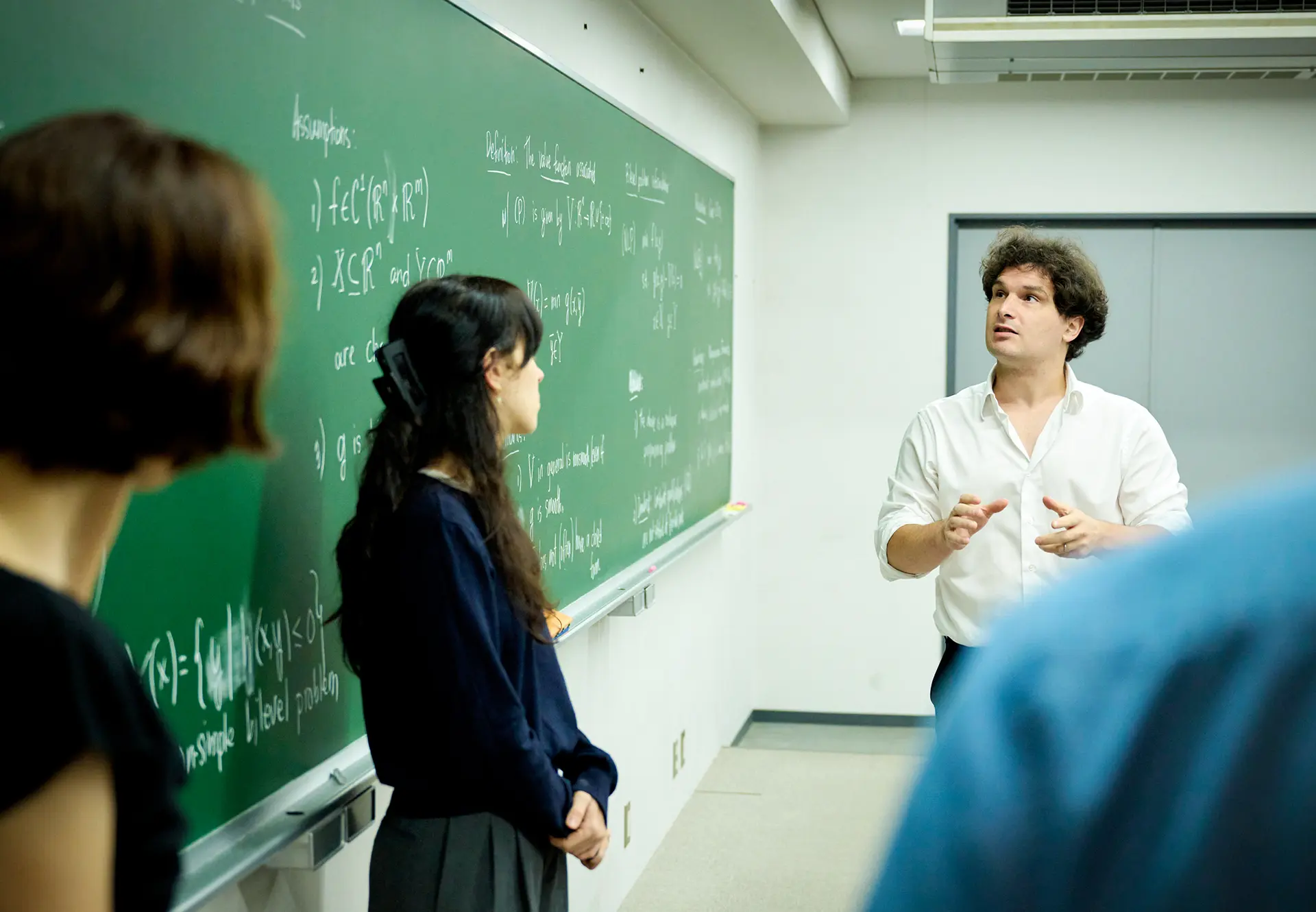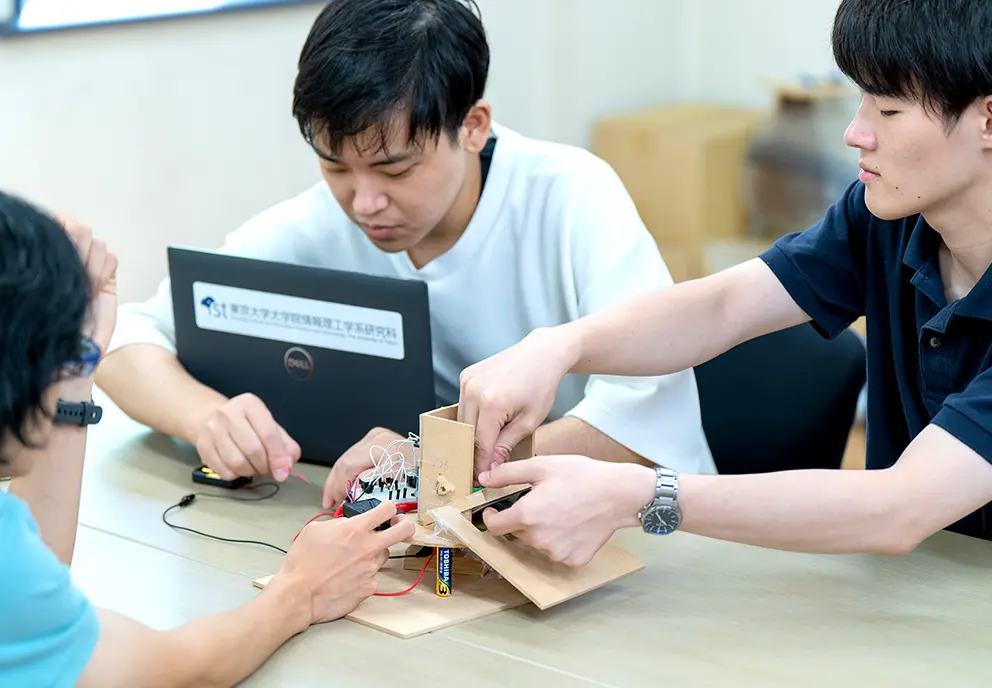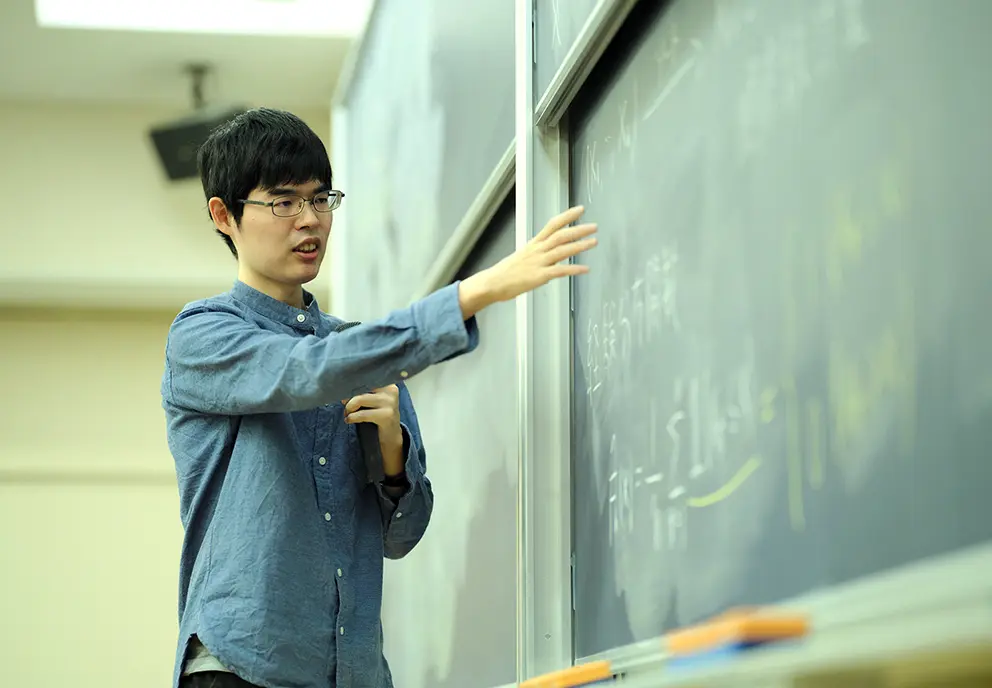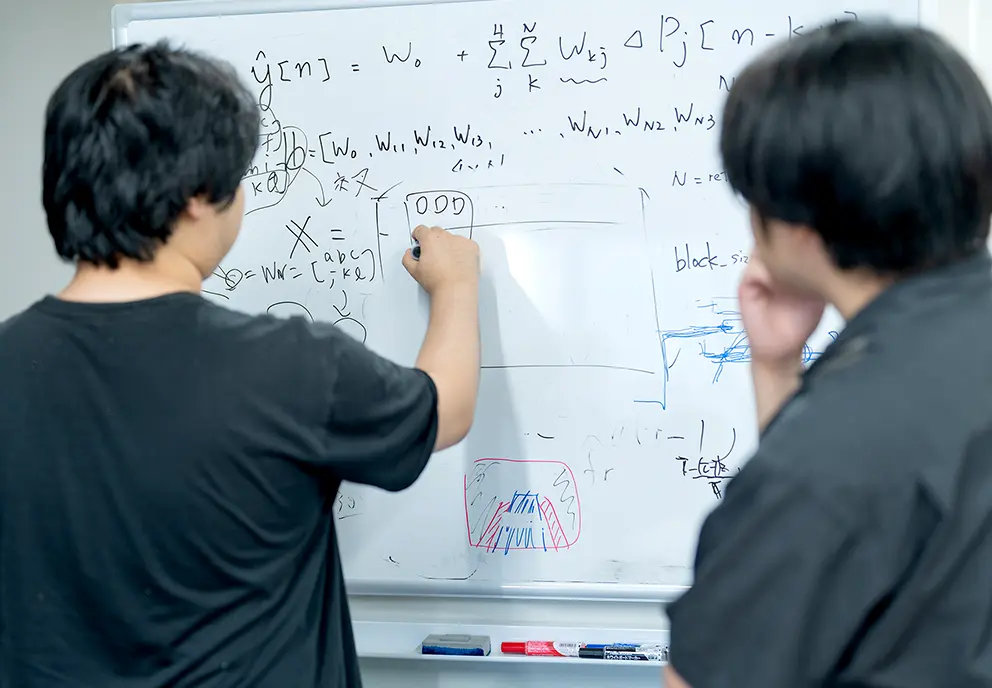Mathematical Information Engineering Course ME Course
Modeling the nature of
phenomena and creating
problem-solving methods

Mathematical engineering is the study of creating mathematical and scientific methods for solving engineering problems. This requires not only a solid understanding of the fundamentals of mathematics and computer science, but also the knowledge and sense to identify and formulate the essence of phenomena, as well as the technology to implement the methods.
The orange areas in the diagram show the curriculum areas of this course of study, which are based on five basic areas and include a variety of advanced topics.
Why don't you study mathematical engineering, which has been applied to various fields of modern society throughout the ages, and learn how to open up the future for yourself?


Faculty List
MEIP
Faculty List of ME
Learn more about the MEIP
through the research of our faculty
Philosophy of the ME Corse
The Mathematical and Information Engineering course aims to master a system of study that combines mathematical and information engineering methods to address engineering problems. Mathematical and information engineering is more than just the application of mathematics and the use of computers. One important mission of information engineering is to solve real-world problems with computers. This requires modeling the structure of the problem and analyzing and formulating a variety of information. Mathematical engineering extracts and analyzes the core of the problem and derives a solution based on logical thinking, including mathematics. These solutions are then applied to actual problems using computers. Mathematical engineering and information engineering are closely related, and one cannot exist without the other.

Confronting the existing order and disorder in the world
A wide variety of methods based on probability and statistics, algebra and geometry, analysis and algorithm theory are studied in mathematical and information engineering. These methods are used not only in engineering, but also in solving problems in a wide range of fields, including society, economics, life sciences, and natural phenomena. However, the fields of application change over time, so the methods need to evolve as well. Mathematical engineers and information engineers must not only learn existing mathematics, but must also have the ability to develop new mathematical methods, the courage to tackle real problems, and the persistence to translate them into real-world problem solving.

Mathematical and information engineering is a methodology-oriented discipline and is not limited to any particular industry. Therefore, professionals are expected to be flexible and work in diverse fields. Their role is to create a new order, explore new areas, or explore different domains. However, they must not isolate themselves from society. They must be willing to work on society's problems. Mathematical and information engineering can be described as a discipline that confronts the existing order and disorder in society.

Of the Department of Aeronautics, which was abolished at the end of the war, three courses were eventually converted and the Department of Applied Mathematics was newly established in March 1946. The goal of this department was to develop fresh engineers and technicians with a broad perspective by taking a cross-sectional view of the mathematical aspects of various engineering problems, constructing a unified theory, and actively exploring new fields of application of modern mathematics. Toward this goal, the Department of Applied Mathematics conducted research and education in applied algebra and geometry, analytical engineering, statistical engineering, mechanical computing, and other fields, establishing a new applied mathematics that was in tune with the times, and until 1954, the department had graduated a total of 114 students.
In 1951, the Department of Applied Physics, consisting of three courses and 11 chairs, was newly established following the new university system. The three courses of the Department of Applied Mathematics were renamed the Mathematical Engineering Course to educate new unique students. In addition, with the reopening of the Department of Aeronautics, one course of the Mathematical Engineering Course was transferred to the Department of Aeronautics in 1954.
In 1962, the Department of Applied Physics was reorganized and expanded to include two departments, the Department of Mathematical Engineering and Information Physics, and the Department of Physical Engineering. In 1962, the Department of Applied Physics was reorganized and expanded to include two departments, the Department of Mathematical Engineering and Information Physics, and the Department of Physical Engineering. At this time, two courses were newly established in the Mathematical Engineering Course, and one course was transferred from the Measurement Engineering Course, bringing the total number of courses to five.
In 1972, the Department of Information Technology was newly established in the Graduate School of Engineering as a so-called horizontal major (a major in which instructors from many departments cooperate in education and research), and the Department of Information Technology was attached to the Department of Mathematical Engineering and Information Physics. Many faculty members of the Department of Mathematics and Computer Science concurrently served in the Department of Information Technology, and the Department of Mathematics and Computer Science played a central role in the Department of Information Technology.
In 1993, the Department of Mathematical Engineering and Information Physics was reorganized as a department in accordance with the University of Tokyo's emphasis on graduate schools, and the faculty members of the Department of Mathematical Engineering and Information Physics were transferred from the Faculty of Engineering to the Graduate School of Engineering (previously, they belonged to the Faculty of Engineering and concurrently taught at the Graduate School of Engineering). With this reorganization, each course was reorganized into a large course of mathematical engineering, and a new course of mathematical and information engineering was added. In addition, due to the change to a large lectureship, the name of research groups in the Department of Mathematical Engineering and Information Physics was changed from "lectureship" to "laboratory".
In 1999, the Department of Complex Science and Engineering was newly established in the Graduate School of Frontier Sciences, and some faculty members of the Department of Mathematical Engineering and Information Physics were transferred to the Department of Complex Science and Engineering. In 2000, the Interfaculty Initiative in Information Studies and the Graduate School of Interdisciplinary Information Studies were newly established to conduct research and education related to information in a manner that integrates the humanities and sciences, and two faculty members from the Department of Mathematical Engineering and Information Physics were transferred to the Interfaculty Initiative in Information Studies as current chairs.
In 2001, the Graduate School of Information Science and Technology was newly established by merging the two graduate schools in order to provide better education and research in the field of information science. Accordingly, the Graduate School of Information Science and Engineering was transferred to the Department of Mathematical Informatics. In addition, the course name of the Department of Mathematical Engineering and Information Physics in the Faculty of Engineering was changed from the Mathematical Engineering Course to the Mathematical Information Engineering Course in response to the organizational change.
Currently, the Course in Mathematical Informatics consists of eight laboratories (including a laboratory in the Systems Division of the Research Center for Advanced Science and Technology), and its faculty members belong to either the Department of Mathematical Informatics, Graduate School of Information Science and Engineering, the Department of Complex Science and Engineering, Graduate School of Frontier Sciences, the Interfaculty Initiative in Information Studies, or the Research Center for Advanced Science and Technology.
- 1946
- Department of Applied Mathematics established.
- 1951
- When the Department of Applied Physics was established, it became the Mathematical Engineering Course of the department.
- 1951
- One course moved to the Department of Aeronautics
- 1962
- Department of Mathematical Engineering and Information Physics is established.
- 1972
- The Graduate School of Engineering establishes a specialized course in information technology, and the Information Processing Engineering Department is attached to the Department of Mathematical Engineering and Information Physics.
- 1995
- Mathematical Principles Course is added to the Mathematical Engineering Course.
- 2001
- With the change of the graduate school, the Mathematical Engineering Course is renamed the Mathematical Information Engineering Course.
Changed the English name from "Mathematical Engineering" to "Mathematical Information Engineering

